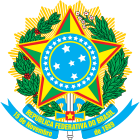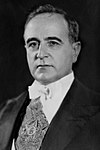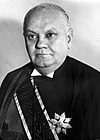
A | B | C | D | E | F | G | H | CH | I | J | K | L | M | N | O | P | Q | R | S | T | U | V | W | X | Y | Z | 0 | 1 | 2 | 3 | 4 | 5 | 6 | 7 | 8 | 9

The president of the Federative Republic of Brazil is the chief executive of the government of Brazil and commander in chief of the country's Armed Forces. Below is a list of presidents of Brazil.
Brazil before the Proclamation of the Republic
Brazil had two monarchs during the time of the United Kingdom with Portugal: Maria I (1815–1816) and John VI (1816–1822). When this Kingdom was created, queen Maria I was already considered incapable due to mental illness and the Portuguese Empire was ruled by prince John, later king John VI, as regent. As an independent nation, Brazil had two monarchs, emperors Pedro I (1822–1831) and Pedro II (1831–1889). The second woman to govern Brazil, after Maria I, was Leopoldina of Austria, who acted as regent in 1822 and had a great influence on Brazil's independence process, having been responsible for signing the decree that separated Brazil from Portugal.
Having proclaimed independence of the Kingdom of Brazil from Portugal in 1822, prince Pedro, the son of king John VI, was acclaimed the first Emperor of Brazil on October 12, 1822. After abdicating the throne, on April 7, 1831, he was succeeded by his son Pedro de Alcântara, who reigned as Pedro II of Brazil. The third woman to rule Brazil was princess Isabel, heir presumptive to the throne, who acted as regent of Brazil in various periods (1870–1871, 1876–1877 and 1887–1888) while her father, emperor Pedro II, performed foreign visits. During her last regency she sanctioned, on May 13, 1888, the Golden Law (Imperial Law No. 3,353), which abolished slavery in Brazil. Pedro II was deposed along with the 74-year-old monarchy on November 15, 1889 in a bloodless and unpopular military coup d'état.
First Republic (1889–1930)
| This article is part of a series on the |
 |
|---|
In 1889, the Empire of Brazil was abolished and replaced with a republic in a coup d'état led by marshal Deodoro da Fonseca, who deposed emperor Pedro II, proclaimed Brazil a Republic and formed a provisional government. The November 15, 1889 military coup began as an attempt to overthrow the Empire's prime minister, Afonso Celso, Viscount of Ouro Preto, but the unprecedented coup against a prime minister appointed by the emperor and who enjoyed the confidence of the elected Chamber of Deputies quickly escalated to the abolition of the monarchy.
With the proclamation of the Brazilian Republic, the Imperial constitution ceased to operate, the Imperial Parliament (the General Assembly) ceased to exist, and not only was the Viscount of Ouro Preto removed from office, but the position of prime minister itself ceased to exist. As head of the provisional government, Deodoro da Fonseca ruled by decree, holding both the functions of head of state and of head of government. The former provinces of the Empire were reorganized as states and the newly proclaimed republic was declared a federation, formed by the perpetual union of those states.
In 1890, elections for a Constituent Congress were summoned and held, but the decree of the provisional government that created the Congress required it to adopt a Constitution that conformed to the recently proclaimed republican system of government, and that organized the recently declared Federal State. In February 1891, a new Brazilian constitution was adopted, based on the federal republic of the United States of America. The country itself was named the Republic of the United States of Brazil. In accordance with the provisions of the Constitution, the presidents of the Republic were to be elected by direct popular vote, but, for the first presidential term, the president and vice president would be chosen by the Constituent Congress; the Constituent Congress was to elect the first president and vice president immediately after the promulgation of the Constitution.
In accordance with those transitional provisions, Congress elected the then head of the provisional government, Deodoro da Fonseca, as the first president of the republic. Marshal Floriano Peixoto was elected by Congress to be the first vice president. The inauguration of the first president and of the first vice president was held on February 26, 1891, only two days after the promulgation of the new Republican Constitution. Deodoro resigned the presidency ten months later after a coup d'état in which he dissolved Congress was reversed. Floriano Peixoto was then inaugurated as president. In 1894, Peixoto was succeeded by Prudente de Morais, the first president of Brazil to be elected by direct popular ballot. Morais, who was the first president to be elected under the permanent provisions of the Constitution adopted in 1891, was also the first civilian to assume the presidency of Brazil.
Although it was theoretically a constitutional democracy, the Old Republic was characterized by the power of regional oligarchies and the seldom broken alternation of power in the federal sphere between the states of São Paulo and Minas Gerais. The vote in the countryside was often controlled by local land owners, and less than 6% of the population had the right to vote due to literacy requirements.
In 1930, when Brazil was suffering the effects of the Wall Street Crash of 1929, a revolution broke out in the country and the Old Republic ended. President Washington Luís, who was supported by São Paulo oligarchies, broke the expected alternation between São Paulo and Minas Gerais and supported a candidate who was also from São Paulo, Júlio Prestes. Prestes won the 1930 election, but Washington Luís was deposed three weeks before the end of his term and Prestes was never inaugurated.
| No. | Portrait | Name (Birth–Death) |
Elected[a] | Term of office[1] | Political party[b] | Vice President | ||
|---|---|---|---|---|---|---|---|---|
| Took office | Left office | Time in office | ||||||
| 1 | 
|
Deodoro da Fonseca (1827–1892) [2] |
1891[c] | 15 November 1889 | 23 November 1891[d] | 2 years, 8 days | Military | Vacant until February 26, 1891 |
| 2 | 
|
Floriano Peixoto (1839–1895) [3] |
— | 23 November 1891 | 15 November 1894 | 2 years, 357 days | Military | Vacant throughout presidency |
| 3 | 
|
Prudente de Morais (1841–1902) [4] |
1894 | 15 November 1894 | 15 November 1898 | 4 years | Federal Republican Party |
Manuel Vitorino |
| 4 | 
|
Campos Sales (1841–1913) [5] |
1898 | 15 November 1898 | 15 November 1902 | 4 years | Republican Party of São Paulo |
Rosa e Silva |
| 5 | 
|
Rodrigues Alves (1848–1919) [6] |
1902 | 15 November 1902 | 15 November 1906 | 4 years | Republican Party of São Paulo |
Afonso Pena[e] |
| 6 | 
|
Afonso Pena (1847–1909) [7] |
1906 | 15 November 1906 | 14 June 1909[f] | 2 years, 211 days | Republican Party of Minas Gerais |
Nilo Peçanha |
| 7 | 
|
Nilo Peçanha (1867–1924) [8] |
— | 14 June 1909[g] | 15 November 1910 | 1 year, 154 days | Fluminense Republican Party |
Vacant throughout presidency |
| 8 | 
|
Hermes da Fonseca (1855–1923) [9] |
1910 | 15 November 1910 | 15 November 1914 | 4 years | Conservative Republican Party |
Venceslau Brás |
| 9 | 
|
Venceslau Brás (1868–1966) [10] |
1914 | 15 November 1914 | 15 November 1918 | 4 years | Republican Party of Minas Gerais |
Urbano Santos |
| — | 
|
Rodrigues Alves (1848–1919) |
1918 | Did not take office[h] | Republican Party of São Paulo |
Delfim Moreira | ||
| 10 | 
|
Delfim Moreira (1868–1920) Acting [11] |
— | 15 November 1918[i] | 28 July 1919 | 255 days | Republican Party of Minas Gerais |
Vacant throughout presidency |
| 11 | 
|
Epitácio Pessoa (1865–1942) [12] |
1919 | 28 July 1919 | 15 November 1922 | 3 years, 110 days | Republican Party of Minas Gerais |
Delfim Moreira[f]
|
| 12 | 
|
Artur Bernardes (1875–1955) [14] |
1922 | 15 November 1922 | 15 November 1926 | 4 years | Republican Party of Minas Gerais |
Estácio Coimbra |
| 13 | 
|
Washington Luís (1869–1957) [15] |
1926 | 15 November 1926 | 24 October 1930[k] | 3 years, 343 days | Republican Party of São Paulo |
Melo Viana |
| — | 
|
Júlio Prestes (1882–1946) [16] |
1930 | Did not take office[l] | Republican Party of São Paulo |
Vital Soares | ||
Vargas Era (1930–1946)
The Vargas Era consists of two different republics: the Second Republic, from 1930 to 1937, and the Third Republic, from 1937 to 1946.
Prior to 1929, Brazilian politics was controlled by an alliance between the two largest state economies; known as "coffee with milk politics", coffee growers in São Paulo combined with the dairy industry centred in Minas Gerais to create an oligarchy, with the presidency alternating between the two states. This practice was broken when the leaders of São Paulo and president Washington Luís nominated their fellow Paulista Júlio Prestes as candidate for the presidential elections in 1930. In response, Minas Gerais, Rio Grande do Sul and Paraíba formed the "Liberal Alliance" backing opposition candidate Getúlio Vargas.
When Prestes won the March 1930 Presidential election, the Alliance denounced his victory as fraudulent, while Vargas's running mate, João Pessoa, was assassinated in July. A revolution then began on October 3, 1930 and quickly spread throughout the country; by October 10, both Rio Grande do Sul and Minas Gerais had announced their support. Washington Luís was deposed on October 24, and the Brazilian Military Junta of 1930 took over; Vargas assumed leadership of the junta on November 3, 1930, marking the end of the First Brazilian Republic and beginning of the Vargas Era.
The 1932 Constitutionalist Revolution led to the adoption of a new Constitution in 1934. However, the constitution was annulled and Vargas became a dictator in the name of law and order in 1937. His rule occupies two periods of Brazilian history, the Second Brazilian Republic and the Third Brazilian Republic, known as the Estado Novo.
Second Republic (1930–1937)
| No. | Portrait | Name (Birth–Death) |
Elected[a] | Term of office[1] | Political party[b] | Vice President | ||
|---|---|---|---|---|---|---|---|---|
| Took office | Left office | Time in office | ||||||
| — | 
|
Military junta of 1930[m] [17] |
— | 24 October 1930 | 3 November 1930[n] | 10 days | Military | Vacant throughout leadership |
| 14 | 
|
Getúlio Vargas (1882–1954) [18] |
1934[o] | 3 November 1930 | 10 November 1937[p] | 7 years, 7 days | Independent | Vacant throughout presidency[q] |
Estado Novo (1937–1946)
| No. | Portrait | Name (Birth–Death) |
Elected[a] | Term of office[1] | Political party[b] | Vice President | ||
|---|---|---|---|---|---|---|---|---|
| Took office | Left office | Time in office | ||||||
| (14) | 
|
Getúlio Vargas (1882–1954) [18] |
— | 10 November 1937 | 29 October 1945[r] | 7 years, 353 days | Independent | Vacant throughout presidency[q] |
| 15 | 
|
José Linhares (1886–1957) Acting [22] |
— | 29 October 1945[s] | 31 January 1946 | 94 days | Independent | Vacant throughout presidency |
Fourth Republic (1946–1964)
In 1945, Vargas was deposed by a military coup led by ex-supporters. Nevertheless, he would be elected president once again and his influence in Brazilian politics would remain until the end of the Fourth republic. In this period, three parties dominated the national politics. Two were pro-Vargas – in the left, PTB and in the centre-right, PSD – and another anti-Vargas, the rightist UDN.
This period was very unstable. In 1954, Vargas committed suicide during a crisis that threatened his government and he was followed by a series of short-term presidents. In 1961, UDN won national elections for the first time, supporting Jânio Quadros, who himself was a member of a minor party allied to UDN. Quadros, who, before his election, rose meteorically in politics with an anti-corruption stance, unexpectedly resigned the presidency seven months later. Some historians suggest that Quadros was heavily drunk when he signed his resignation letter, while others suggest that Quadros felt that Congress would not accept his vice-president as president, and would ask for his return. Those historians, therefore, see Quadros' resignation as an attempt to return to office with increased powers and more political support. It is possible that both occurred: Quadros was drunk when he resigned, and in that state, he devised the plan to return to power by Congressional request. The plot failed: Congress simply received Quadros' letter, and amid the shock of politicians and of the Nation, the letter was entered into the records of Congress and the presidency was declared vacant. The president of Congress, Senator Auro de Moura Andrade, took the view that the deed of resignation was the province of the elected president, that it was not subject to a congressional vote, needing no confirmation, and that the president's declaration of resignation was final.
At that time, the president and vice president of Brazil were voted into office separately. The vice president was a political enemy of Jânio Quadros, the leftist João Goulart. Goulart was out of the country, and Congress was controlled by right wing politicians. During Goulart's absence, the president of the Chamber of deputies, Ranieri Mazzilli, took office as acting president of Brazil. There was then a plot to block the inauguration of the vice president as president, but Congressional resistance to the inauguration of Goulart led to a reaction by the governor of Rio Grande do Sul, who led a "legality campaign", and to a split in the military (that, during the fourth Republic, intervened heavily in politics). Amid the political crisis, the solution was the adoption by Congress of a Constitutional Amendment abolishing the presidential executive and replacing it with a parliamentary system of government. Under that negotiated solution, Goulart's inauguration was allowed to proceed, but Goulart would be head of state only, and a prime minister approved by Congress would lead the government. The new system of government's continued existence was subject to popular approval in a referendum scheduled for 1963. The result of this referendum restored the presidential executive and a military coup deposed Goulart in 1964, starting the military dictatorship.
| No. | Portrait | Name (Birth–Death) |
Elected[a] | Term of office[1] | Political party[b] | Vice President | ||
|---|---|---|---|---|---|---|---|---|
| Took office | Left office | Time in office | ||||||
| 16 | 
|
Eurico Gaspar Dutra (1883–1974) [23] |
1945 | 31 January 1946 | 31 January 1951 | 5 years | Social Democratic Party |
Vacant until September 19, 1946 |
| 17 | 
|
Getúlio Vargas (1882–1954) [18] |
1950 | 31 January 1951 | 24 August 1954[f] |
3 years, 205 days | Brazilian Labour Party |
Café Filho |
| 18 | 
|
Café Filho (1899–1970) [25] |
— | 24 August 1954[u] | 8 November 1955[v] | 1 year, 76 days | Social Progressive Party |
Vacant throughout presidency |
| 19 | 
|
Carlos Luz (1894–1961) Acting [26] |
— | 8 November 1955[w] | 11 November 1955[x] | 3 days | Social Democratic Party |
Vacant throughout presidency |
| 20 | 
|
Nereu Ramos (1888–1958) Acting [24] |
— | 11 November 1955[y] | 31 January 1956 | 81 days | Social Democratic Party |
Vacant throughout presidency |
| 21 | 
|
Juscelino Kubitschek (1902–1976) [27] |
1955 | 31 January 1956 | 31 January 1961 | 5 years | Social Democratic Party |
João Goulart |
| 22 | 
|
Jânio Quadros (1917–1992) [28] |
1960 | 31 January 1961 | 25 August 1961[d] | 206 days | National Labour Party | |
